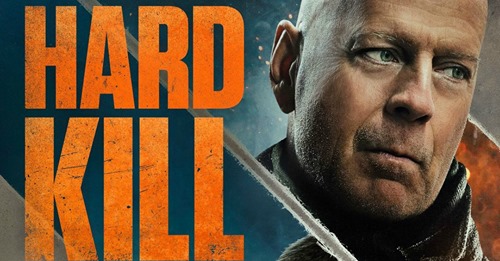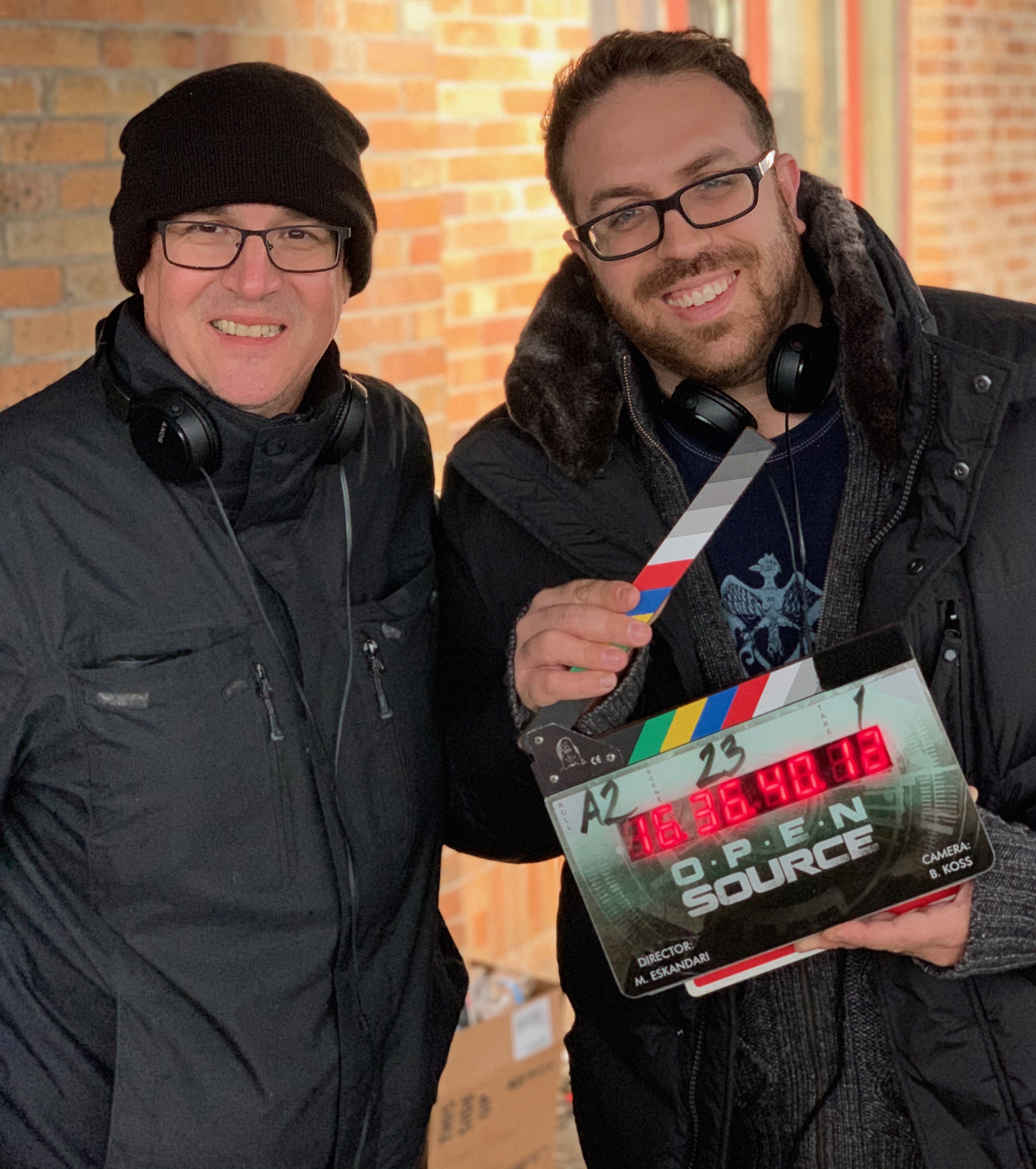With a dearth of new movies during this pandemic summer, the release of a new thriller starring one of the biggest action stars in Hollywood is big news. And it’s especially exciting for the two Arizona State University alumni who wrote the screenplay: Chris LaMont, an instructor in the New American Film School at ASU, and Joe Russo, who lives in Los Angeles.
“Hard Kill,” starring Bruce Willis, will debut at drive-ins and movie theaters on Aug. 21 and will be available through video-on-demand starting Aug. 25.
LaMont, who graduated in 2005 and is a clinical assistant professor in the New American Film School, started writing the screenplay years ago with Russo, who graduated in 2008 with degrees from the film school and the Walter Cronkite School of Journalism and Mass Communications.
The two have honed their collaboration into a successful partnership that Russo compares to a marriage.
“It’s almost like having a spouse,” said Russo, who was LaMont’s student at ASU.

The screenplay for "Hard Kill," starring Bruce Willis, was written by ASU alums Christopher LaMont and Joe Russo.
“He ripped my short film apart,” Russo said. “But it was great because I fixed it and it played at the Arizona Student Film Festival and it was so great to see my work on the big screen.”
LaMont is a founder of the Phoenix Film Festival. The team also wrote the movie “The Au Pair Nightmare,” which Russo directed. That appeared on the Lifetime network in May. And Russo is set to co-produce the upcoming biopic of Hulk Hogan, starring Chris Hemsworth and directed by Todd Phillips.
The two Sun Devils answered some questions from ASU Now:
Question: How did you end up writing a Bruce Willis movie?
Russo: A few years ago, Clayton Haugen had an idea for an action movie and Chris and I came on to write the story. When we finished it, we took it to our agents and waited. Then Clayton had a chance encounter with the producer, Randall Emmett, at a Kentucky Fried Chicken in Arizona. He went up to him and said, “Hey, I know your development executive from high school and I have an action script.” And Randall said, “Great, we’ll read it.” And so the script never even went to market. It ended up being a crazy story.
Q: How long was the process?
LaMont: It generally takes about three months to write a script with several rewrites. We started in 2015 and the idea was that they would go into production within the year. It takes that much time to get financing.
Then a lot of time passed. They were interested in the project and they really wanted to do it but it kept getting pushed back because of scheduling.
In 2019 they came back and said, “We’re going to do your movie before the end of the year,” and we got really excited when they said that Bruce Willis was interested in being in the movie.
They asked us to go back and take one of the characters and really punch him up to fit into Bruce Willis’ demeanor and the kind of character he plays. So we went through and did one more pass.
Video courtesy Movieclips Trailers
Russo: The tricky thing is that then it went to a different distributor. So last summer, as I was finishing up “Au Pair Nightmare,” we got a call from the new distributor, saying, “The good news is that we’re going to make the movie, but the challenge is that you have to reshape it.”
They know their audience and they had a specific idea they wanted for the movie.
I was editing “Au Pair Nightmare” during the day and rewriting “Hard Kill” at night.
Q: How did you revise the script for Bruce Willis?
LaMont: The role he plays in the movie is a tech billionaire, and we saw it as a Steve Jobs character, who is brilliant.
In the movie, his daughter, who is also a genius, is kidnapped by a terrorist organization.
So when Bruce Willis came on board, his character isn’t going to sit in front of a computer and tell people what to do. We needed to get him in into the action. He has to shoot guns and fight people.
So we came up with the action scenes and dialogue, everything. Also it was originally called “Open Source” and they changed the name.
The whole idea with professional screenwriting is that there is no such thing as an overnight success. I can’t tell you how many times we rewrote that script.
Q: Did you get to see Bruce Willis?
LaMont: Finally, in January of this year, they started filming in Cincinnati in an old abandoned factory.
Joe and I flew out there and were there for the first couple of days of production.
It was really cool seeing Bruce saying our words. He is an icon of the movies. Who doesn’t love “Die Hard”? To have “John McClane” saying clever quips is every screenwriter’s dream.
ASU alum and instructor Chris LaMont took this photograph of Bruce Willis on the set of "Hard Kill" in January.
Russo: We were there to be cheerleaders. Most movies don’t want to have the writers on set, so we decided to pick the days that Bruce would be there.
I found it interesting because you don’t usually get to watch other filmmakers in action. I got to watch (director) Matt Eskandari interact with an actor who is a superstar. It was interesting to see how willing Matt was to let Bruce improvise. And the more he improvised, the more emotionally tied to the scene he was. At one point Bruce called a character an “effing terrorist,” and Chris and I looked at each other and said, “That wasn’t in the script, but it was great.”
Q: Was the movie affected by the pandemic shutdown?
LaMont: The movie was shot over two and half weeks in January and they started editing the film immediately. When COVID hit, the editing slowed down, but then things got back on track.
Russo: When the shutdown happened in March, I had two or three friends from distributors call me and ask, “What’s going on with ‘Au Pair Nightmare’?" And I told them I sold it to Lifetime. They said it was too bad because they were trying to scoop up as much content as they could.
So I wasn’t worried about “Hard Kill,” because I knew we had a finished product.
Q: What’s it like navigating Hollywood?
LaMont: The relationships are the most important thing, along with a good reputation and being talented. You need those three things to be successful in the industry.
There are a lot of disappointments. I can’t tell you how many projects we’ve written that have gone nowhere.
People have to understand that if someone believes in a movie, they’re putting millions of dollars on the line for your vision as a writer. It’s all about finding the right fit. Finding a producer who is looking for your specific movie.
One of the reasons we fell into the genre of suspense thriller horror films is that those are the kinds of films that producers love to make because they have wide audience appeal. I love Alfred Hitchcock, so we’ve been a fan of writing those types of suspense films.
New American Film School Clinical Assistant Professor Chris LaMont, left, and his writing partner, Joe Russo. Both are graduates of ASU.
Q: How does your writing collaboration work?
LaMont: We’ve written 15 screenplays together and our writing is so much better than when we started.
It does come down to a mutual respect. My writing partner works harder than me, which is amazing. We come up with an idea, come up with the characters, and go through and break down a story outline. Basically, we come up with all the pieces in advance. If a producer reads through a treatment and they like it, they will give you the green light to start writing the screenplay.
We send drafts back and forth. It’s liberating to have someone who works with you that you know will have your back and be completely objective and they love movies as much as you do.
It’s all remote. We were doing Zoom calls before Zoom, going back and forth on speaker phone.
Q: Will you have a watch party?
LaMont: We’re going to get a big inflatable screen and watch in our front yard, socially distanced.
We haven’t seen the final product so we’ll see it with the rest of the world. Once the screenplay is written, the producer and director take over and they’re the creative filter. They guide the film to its completion.
Q: What’s your advice to film students?
Russo: I wish I had read more screenplays. Chris and I didn’t magically become great writers. It took lots of work and lots of reading good, bad and ugly screenplays to figure out what works and what doesn’t, and how to get that emotion on the page.
I wish I had focused more on the story than on where to put the camera. Because when the story is good, you can put the camera anywhere.
Q: Chris, what do you teach?
LaMont: I teach screenwriting and I teach “Film: The Creative Process,” which goes over all the steps involved in making a movie. I teach a class on producing and a career class. And I’ve developed online classes in comedy films and Alfred Hitchcock.
As a faculty member, it’s great to show our students that everyone at the New American Film School is continuously working. We’re all active in the industry, and it’s important for our students to be able to see faculty being successful, and showing them that you can make it if you really work hard.
Top image courtesy of Pixabay
More Arts, humanities and education

Learning by stepping outside
By Adriana MaestasAmid a world increasingly captivated by all things digital, more than 200 Arizona teachers have crafted immersive educational experiences that nudge students to step away from their…

Behind the curtain: Discovering careers in the arts at ASU Gammage
For a group of students from Sunnyslope High School, Eastmark High School and AZ Teen Homeschool Co-op, a recent December day at ASU Gammage became much more than just a field trip. It became an eye-…

Honoring a legacy of cultural education, exploration
Belle Edson has inspired countless students to expand their horizons during her 26-year tenure at Arizona State University. A beloved professor and director of undergraduate studies and core courses…


